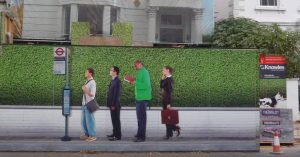How Printed Hoardings Impact UK Brands: The Art of Visual Storytelling:
Visual storytelling is an art form that has been around for centuries. From cave paintings to modern-day advertising campaigns, people have always used the power of visuals to convey a message and tell a story. One medium that has been particularly effective in this regard is printed hoardings. In the UK, these towering advertisements have become synonymous with brand awareness and visual impact. But what makes them so effective? How do they work their magic on consumers? And how can brands leverage this powerful tool for their own storytelling purposes? Join us as we dive into the world of printed hoardings and explore the art of visual storytelling like never before!

The history of printed hoardings in the UK
The history of printed hoardings in the UK dates back to the early 19th century when advertisers began using them as a means of promoting their products or services. Hoardings were initially made from wood, but eventually evolved to include other materials like metal and plastic.
In the late 1800s, the rise of mass communication technologies such as newspapers and magazines led to an increase in demand for outdoor advertising. Printed hoardings became more widespread, with businesses realizing their potential impact on consumers.
During World War II, hoardings were used for public service announcements related to air raid precautions and rationing. After the war ended, they continued being used for advertising purposes.
The 1960s marked a turning point for printed hoardings in terms of design and aesthetics. Artists like David Hockney created stunning visuals that caught people’s attention while also conveying marketing messages effectively.
Today, printed hoardings continue to be popular among brands across various industries due to their ability to capture audience attention and convey brand messaging effectively. With advancements in technology allowing for greater customization and personalization options, we can expect even more exciting developments from this form of visual storytelling in the future.
Principles of effective visual storytelling
Effective visual storytelling through printed hoardings is all about grabbing the attention of passersby, engaging them with a compelling narrative and ultimately persuading them to take action.
Types of printed hoardings in the UK
There are various types of printed hoardings that UK brands can use to tell their visual story. Each type has its unique strengths and is suitable for different campaigns and locations.
One type of hoarding is the mesh banner hoarding, which allows wind and light to pass through while maintaining vibrant colours. This makes it ideal for outdoor events or construction sites where visibility from a distance is critical.
Another popular option is the PVC banner hoarding, which offers a cost-effective solution with high-quality printing capabilities. It’s also easy to install on fences or walls, making it perfect for promoting upcoming events or product launches.
For more permanent installations, aluminium composite panel (ACP) hoardings provide durability against harsh weather conditions and vandalism. They’re often used in retail spaces or corporate headquarters to showcase brand identity with professional finishes.
There’s the traditional paper poster-backed hoarding which still holds relevance in high footfall areas like shopping malls or sports stadiums. These life-sized posters grab attention quickly with colourful graphics that convey messages directly without overwhelming viewers.
Choosing the right type of printed hoarding depends on factors such as campaign objectives, location and budget constraints. However, all types offer an opportunity for brands to create visually compelling stories that resonate with audiences long after they’ve left their sights.
Creating impactful hoarding designs
Creating Impactful Hoarding Designs is a crucial aspect of visual storytelling. A good hoarding design should be eye-catching, memorable and communicate the intended message effectively.
Another important factor when creating impactful hoarding designs is the size of the text used. It’s essential to use large, readable fonts that are easy on the eyes from a distance. If someone can’t read what you’re trying to say, then it defeats the purpose of having a hoarding in place.
Incorporating images or graphics related to your brand or message can also make your hoardings more impactful. Having strong visuals alongside concise messaging will leave a lasting impression on passersby.
It’s important to remember that less is often more when it comes to effective hoarding designs. Keep your message simple and straightforward so that anyone walking by can understand it without much thought or confusion.
Ensure that your design aligns with any existing branding guidelines for consistency across all marketing efforts. Consistency builds trust with consumers and reinforces brand recognition over time.
Creating Impactful Hoarding Designs requires careful consideration of colour schemes, font sizes, imagery selection and messaging simplicity while maintaining consistency throughout all campaigns.
Localisation and personalisation in hoardings
Localisation and personalisation are crucial in creating effective printed hoardings that resonate with the target audience. Localisation involves tailoring the hoarding design to suit the specific location where it will be displayed, taking into account factors such as local culture, language and traditions.
Personalisation, on the other hand, involves using data-driven insights to create tailored messages for different demographics within a particular location. Personalising content based on age, gender or interests can make a significant impact on how well audiences receive your message.
Incorporating these two elements into your hoarding design can help you connect with potential customers at a deeper level. For instance, you could use locally recognised landmarks or colloquial phrases in your designs to resonate more effectively with locals.
Similarly, if you know that certain groups of people frequent an area more than others do – such as commuters travelling through public transport hubs – then targeting them specifically through personalised messaging could drive higher engagement rates.
By implementing localised and personalised elements in your printed hoardings campaign strategy, you can potentially boost brand recognition and build stronger customer relationships.
The intersection of digital and physical hoardings
As technology continues to evolve, the intersection of digital and physical hoardings has become increasingly common in the UK. With consumers spending more time on their devices, brands are finding new ways to integrate digital elements into their traditional printed hoardings.
One way this is being done is through QR codes that allow users to instantly access a brand’s website or social media pages by simply scanning the code with their Smartphone. This integration can add an interactive element to traditional hoarding designs and encourage engagement from passersby.
Another popular trend is incorporating LED screens into hoarding designs. These screens can display high-quality images or videos that capture viewers’ attention and provide additional information about the brand or product being advertised.
The intersection of digital and physical hoardings offers endless possibilities for creative visual storytelling. By integrating modern technologies with traditional print advertising, brands can create compelling campaigns that engage audiences both online and offline.
Measuring the impact of printed hoardings
Measuring the impact of printed hoardings is crucial to understanding the effectiveness of your advertising campaign. There are several key metrics that can be used to evaluate the success of a hoarding, such as reach, impressions, and engagement.
One important way to measure impact is through foot traffic. By analyzing how many people walk past your hoarding and comparing it with other marketing efforts in the area; you can determine whether or not your hoarding is attracting attention.
Another metric to consider is brand recall. Did viewers remember your brand after seeing the hoarding? Conducting surveys or focus groups before and after displaying a hoarding can help gauge its effectiveness in terms of brand recognition.
Engagement rates are also critical because they indicate whether viewers were interested enough in your message to interact with it further. Social media shares or website visits resulting from a specific call-to-action on a hoarding are examples of this type of measurement.
Measuring the impact of printed hoardings requires careful planning and analysis. By using multiple metrics in conjunction with each other, you can gain valuable insights into how effective your visual storytelling really is.
Planning and executing a printed hoarding campaign
Planning and executing a printed hoarding campaign requires careful consideration of various factors to ensure its success. Firstly, it is important to identify the target audience and their preferences in terms of design, messaging, and placement. This will help determine the appropriate size, location, visuals, and content for the hoardings.
Secondly, budget plays a crucial role in determining the scale of the campaign. It is important to consider costs such as printing, installation, maintenance and removal when creating a realistic budget plan.
Thirdly, selecting an experienced creative agency or designer with expertise in hoarding design can make all the difference. A strong team will work together to create designs that resonate with your target audience while also being visually appealing.
Fourthly, timing is key; it’s essential to understand how long you want your hoardings up for before planning any further stages of advertising so that they are seen by as many people as possible within this time frame.
Legal and ethical considerations for printed hoardings in the UK
When it comes to creating printed hoardings, there are several legal and ethical considerations that brands should keep in mind. First off, all hoardings must comply with local council regulations and obtain the necessary permits before installation. Failure to do so can result in fines or even removal of the hoarding.
In terms of content, hoardings must not contain any offensive or discriminatory language or imagery that could harm a particular group of people. Brands also need to ensure they have obtained the necessary rights and permissions for any copyrighted material used on the hoarding.
Moreover, brands should be mindful of their environmental impact when creating printed hoardings. The use of eco-friendly materials and responsible disposal after use can go a long way towards reducing waste and promoting sustainability.
It’s important for brands to consider how their message may be perceived by different audiences. Hoardings should never promote harmful messages or perpetuate negative stereotypes.
By taking these legal and ethical considerations into account when designing printed hoardings, brands can create impactful campaigns while still upholding their social responsibility.
The future of printed hoardings in the UK
The future of printed hoardings in the UK is looking bright, with advancements in technology and a growing trend towards experiential marketing. As consumers become increasingly visually literate, brands will need to find new ways to engage them and stand out from the crowd.
Another development is the rise of eco-friendly materials and sustainable printing practices. With increasing pressure to reduce waste and carbon emissions, brands are looking for ways to make their advertising more environmentally friendly without sacrificing impact.
Personalisation is also set to play an important role in the future of printed hoardings. By tailoring messaging and imagery to specific locations or demographics, brands can increase relevance and engagement with their target audience.
While traditional printed hoardings will continue to have a place in advertising campaigns for years to come, we can expect exciting new developments that push boundaries and challenge expectations as technology advances further.
To sum up, printed hoardings have been an integral part of the advertising industry for centuries. They offer a unique opportunity to brands and marketers to tell their stories in a visually compelling way. With advances in technology, it is now possible to create highly personalised and targeted campaigns.
By following the principles of effective visual storytelling, creating impactful designs, localising content, measuring impact and adhering to legal and ethical considerations, UK brands can leverage the power of printed hoardings to connect with their audience on a deeper level.
As we look towards the future of advertising, it is clear that printed hoardings will continue to play an important role in communicating brand messages. By embracing new technologies such as augmented reality and digital integration with physical displays, there are even more opportunities for creativity and innovation.
If you’re looking for a powerful way to tell your brand’s story through visual media please do not hesitate to contact us at justin.murray@projectprintmanagement.co.uk.
For our latest print projects please visit our blog.





